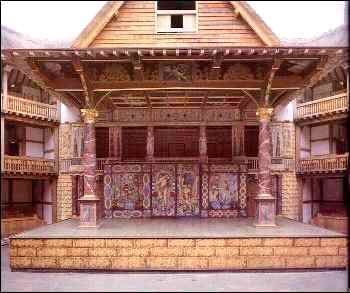Entrances and exits
Jacques: All the world's a stage,
And all the men and women merely players;
They have their exits and their entrances, (As You Like It, 2. 7. 139-41)
How many entrances were there onto the Globe stage? The Swan diagram shows two; but if there were only two entrances, how did the actors prevent "traffic jams" as one scene ended and another began? How did they remember which exit to use, given that actors were sometimes expected to perform several different plays in a single week? Of course, sometimes both doors would be used, when actors would meet, coming from different places.
There is clear evidence that the doors were often labelled in the performances of classical plays at the Universities, so that the audience would know where the actors were coming from (see the illustration to the works of the Roman comedian Terence). But the public stage had very different conventions from the scholars at the universities.
There have been a number of theories to explain how actors co-ordinated their movements on and off stage. One holds that actors always entered by the last door they left (a reasonable assumption, since an audience might expect this). The problem, however, remains that there is no reliable way to decide how actors would know how to enter, and the result might again be confusion at one or other of the doors. Alternatively, actors might consistently move across the stage, say from left to right. This way there would be no congestion, but there would be no opportunity for the dramatic use of an unexpected entrance either.
One possibility is that one door tended to represent "within," the other "outside." The actual meaning of these two "places" would change as the action changed, but the convention would give actors a consistent way of remembering where they should go. This way of planning the entrances and exits produces surprisingly few awkward moments where a door is used for both an entrance and an exit.
Was there a central door as well as the two main ones?
Consult an article discussing some of the problems with entrances and exits.
